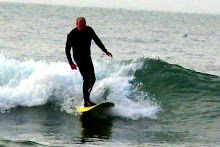
| Pacifica | Linda Mar |
| 9:15 am to 10:00 am | Consistent 5' to 6', sets to 10' |
| Mid, upcoming tide | Slight cross breeze |
| High bright sky with low mist like fog | Confidence building session |
Big Boomers prevailed at Linda Mar this morning, Big Boomers.
I had just made it out having gone under white water of two waves and was resting north of the restrooms at Linda Mar when the first big set came through. I couldn’t believe the size of the wave I saw. It’s been a long time since I have been in swells of this magnitude. Coming at me was a mountain of blue-gray water that filled the horizon, stretching from one end of the cove to the other. My heart started pounding, my sight narrowed and focused on the top of the closest point of the wave to me, and I started paddling with all I had. I made it over the top as lip was beginning to feather with white water. I descended into a valley of water and looked up to see another huge swell approaching. Sailors understand this experience. A boat rises over a steep swell; the bow drops into the valley between seas and begins ascending up the face of the next wave. That’s what it felt like frantically stroking over these waves. After making it over the second wave, there was a third monster approaching, and I barely made it over that one also. This was certainly a wake-up call to pay attention to approaching sets. I didn’t want to be caught inside when these monsters came marching in. End-to-end walls boomed into curtains of water a hundred yards long. Kevin and I agreed these waves were at least ten feet. Every ten minutes a monster set of unrideable waves would come through.
Being a Friday before a three-day holiday, Kevin’s unit at work was slacking off. He called yesterday stating that this was a good morning to go surfing. I picked him up in the morning and we headed for Pacifica. The swell had come up overnight, a big wind swell with a long frequency period: west-north-west swell, 6.9 feet at 11 seconds and little to no wind. Stormsurf predicted six to eight foot faces at Pacifica and they were spot on.
A big crowd was already in the parking lot when we pulled in. Big walls were crashing out front. We could not see the north or south end of the cove due to a low, thin fog/mist. Ben, my old buddy from my days at Visa, and his friend, Brad were there. They had traveled up the coast from Half Moon Bay and reported on conditions down south: Kelly Ave was huge and closed out, the Jetty was flat due to the tide being too high, and Montara was also huge and closed out. Bottom-line: we’re surfing here. Kevin as usual had things to do, like a lunch with his work buddies in the City; we agreed to be out of the water at 10:00 am. Our strategy was to enter the water out front and then paddle north where the waves were bigger. Again my son was coaxing me into waves much bigger I am used to.
Having entered the water at 9:15 am, I had forty-five minutes. In that time I caught four waves, all of them overhead. The smaller waves, those five to eight feet, were rideable and quite good. To catch them I had to move inside and risk being caught inside by the monster sets. Fortunately, at Linda Mar one can see the sets approaching from a long ways off. I also kept a close eye on the guys sitting way out there. If they started paddling out, so did I. A sizable wall approached, it looked like it had some direction to the left and it was feathering at the top. I went for it. The wave was steeper than I realized, my board went vertical as I quickly jumped to my feet. I dropped half way down the face, looked up and the top of the wave was two feet over my head. With my heart in my throat, I powered below the white water that was sliding down in front of me, climbed back into the swell, stepped to the middle of the board, crouched down and sped across a huge wall of water. Now I was in control and worked the wave into the shore break. Wow, what a ride, I was ready for another one.
I connected with a right on my second wave, another large wall that was feathering at the top. I was paddling hard for it, felt the board rise up several feet as the large swell passed under me, thought I was into the wave, jumped up but I had jumped up too soon. I hung at the top of a steep, overhead wave. Oh no I was into it, I dropped straight down, stood on the tip of the tail block to keep the nose up, for an instance the nose dipped into the water and then bounced back up. I managed to hang on and out front of the turbulence of shoulder high white water. On my third wave I dropped down six foot left wall, was gaining speed when I had to maneuver around a guy paddling out, tried to power back into the swell but didn’t make it. On my last wave, I worked it into the shore break, pulling out within ten feet of dry sand.
Kevin and I had a great time and my confidence soared after having handled some sizable waves.








